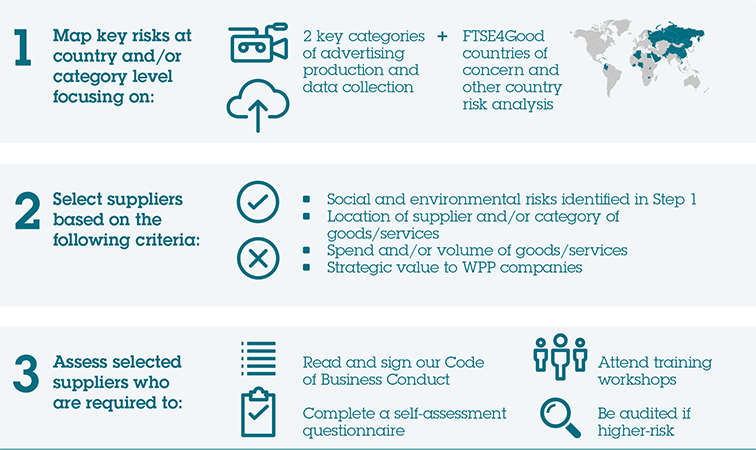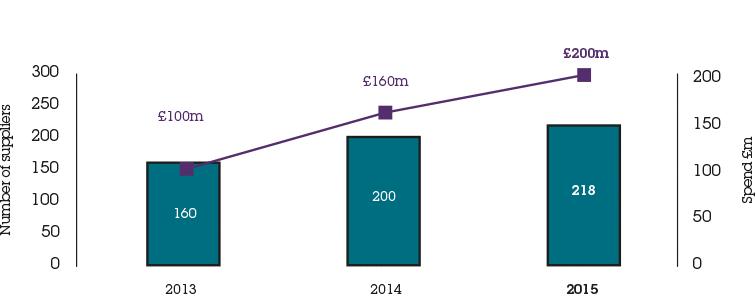Our supply chain
Around half of our spend is with WPP preferred suppliers who provide goods and services to our companies, such as IT, travel, telecommunications, professional services, facilities and IT management. Many of these contracts are negotiated centrally.
The other half of our spend is primarily made up of goods and services used in client work, such as advertising production, market research operations and other marketing services. These contracts are usually smaller and negotiated by budget holders within our companies.
To track spend with suppliers and monitor performance, we have implemented an online analytics system that enables us to monitor 70% of our total spend with suppliers across 12 of our largest markets.
The large numbers of suppliers we work with and the diversified nature of procurement within WPP means
we have to prioritise our efforts. We currently focus on tier-one suppliers, those with whom we have a direct commercial relationship. Higher-risk practices may be more likely to occur further down the supply chain, for example among raw material suppliers. We do not have a direct commercial relationship with these suppliers, however, by working with our tier-one suppliers and requiring them to implement their own supply chain management programs, we can influence standards further down the supply chain.
Our standards for suppliers
We expect suppliers to adopt standards that are consistent with our own. These are set out in the supplier
version of our Code of Business Conduct, which explains how our own Code should be applied by companies
in our supply chain. It includes requirements relating to labour practices (such as wages, anti-harassment and discrimination and health & safety), human rights (including no child, forced or bonded labour), social impacts (such as anti-bribery and corruption) as well as other sustainability issues.
Our procurement policy is also aligned with the WPP Data Code of Conduct, our data protection and privacy principles, our Sustainability Policy, and our Human Rights Policy Statement.
Our key policies and information about our approach are available to suppliers and prospective suppliers on our website, wpp.com/wpp/about/how-we-buy.
The UK’s Modern Slavery Act now requires companies to explain their approach to preventing slavery in their operations and supply chain. We are reviewing our policies and processes to ensure they comply with the Act
and will publish a statement explaining how we assess and manage risks relating to slavery in our operations
and supply chain.
How we select suppliers
We evaluate potential new suppliers on factors such as assurance of supply, quality, service, cost, innovation and sustainability. Our sustainability criteria cover six areas: policy; senior responsibility; materiality and identification of key issues; reporting; supply chain; and anti-bribery and corruption. We do not have a standard weighting for sustainability criteria, which varies from supplier to supplier.
All WPP companies and Group buyers are required to take the following steps when selecting suppliers:
- Conduct due diligence to assess whether suppliers pose a potential financial or reputational risk to WPP or its clients.
- Assess operational, commercial and sustainability criteria to determine whether suppliers are fit for purpose.
- Apply our anti-bribery and corruption policies.
- Have suppliers read and sign the supplier version of the WPP Code of Business Conduct, confirming that they will comply with our standards.
- Include a right-to-audit clause in purchase orders where appropriate.
How we monitor risks
We have identified two areas of our supply chain where breaches of our Code could have a potentially significant impact on WPP’s reputation or that of our clients. These are:
- Advertising production: this part of our supply chain involves many small companies and costs for these services are typically passed onto clients.
- Data collection: a higher-risk area because of the importance of protecting consumer data and the many legal and contractual requirements relating to data security and privacy.
We are working more closely with suppliers in these areas to identify and manage risks. We focus our engagement on suppliers who represent a potentially higher risk due to factors such as spend, the type and volume of goods or services we buy, a supplier’s strategic value to WPP or their location. See chart below.
Selected suppliers are asked to complete a self-assessment questionnaire, provided by Sedex, the not-for-profit membership organisation which works to share sustainability data across supply chains. It covers four areas: employment practices; health and safety; business ethics; and environmental management. Responses are analysed using the Sedex risk tool, enabling us to assess the level of potential sustainability risk associated with each supplier.
Over the last three years (2013-2015) we have assessed 218 advertising production and data collection suppliers working with our companies in China, the UK and the US. This covers £200 million in annual spend, or approximately 12% of our total spend on advertising production and data collection.
Supplier risk monitoring
We follow 3 key steps:

Advertising production suppliers
Since 2013, we have assessed 195 suppliers, the majority of which carry a medium sustainability risk as defined by Sedex. Based on the issues identified during this process, we hold supplier meetings and workshops and train suppliers on the practical steps they can take to align with our Code of Business Conduct.
We held two training sessions with our procurement teams responsible for advertisement production in the US during 2015 to raise awareness of the key environmental and social issues associated with advertisement production and to review the performance of key suppliers. We are also conducting audits for selected higher-risk suppliers.
Data collection suppliers
Since 2013, we have assessed 23 suppliers that provide and/or manage data for Kantar, KBM and Xaxis. In addition to signing our Code of Business Conduct – Supplier Version and completing the Sedex questionnaire, these suppliers are also asked to read and sign the WPP Data Code of Conduct and complete a WPP-designed data security and privacy survey. Areas covered include supplier standards for collection, use, storage and transfer of data, physical security measures, testing, access controls and data security accreditations and certifications. This methodology is based on the WPP Data Health Checker (see Monitoring implementation for more information).
Our assessment results show that all the suppliers carry a medium sustainability risk as defined by Sedex, and that 75% of the suppliers involved have taken mitigation measures that match or exceed their level of data security and privacy risk. On average, suppliers were found to have a risk score of 3.25 out of 5, with 5 being the highest level of risk, and a mitigation score of 3.55 out of 5, with 5 being the highest level of mitigation. Of those suppliers surveyed, 70% have trained their employees on data protection and information handling.
During 2016, we will work to further strengthen our approach in this area and expand our risk program to other countries in partnership with the Data Alliance, the horizontal team supporting our data businesses by helping companies across the Group access and leverage data.
Read more about our approach to Privacy and our Data Code of Conduct.
Suppliers and spend covered by our supply chain risk program

- Number of suppliers
- Spend £m
How we work with suppliers on sustainability
We work with suppliers to reduce the environmental impact of our procurement and to increase diversity in our supply chain. This includes:
- Living wage: We are working with suppliers in the UK to make sure that on-site contractors (cleaning, security and catering providers) receive the living wage.
- Diversity: We incorporate diverse suppliers in our supply chain, including small businesses and those owned by women and minorities. This enables us to comply with client requirements in markets such as the US, and can boost innovation and creativity.
- Green goods and services: We have identified preferred suppliers for our operating companies to use, which provide goods and services with better environmental credentials for energy, paper and waste management.
- Carbon emissions: We have estimated the carbon emissions of our supply chain and plan to work with suppliers to target reductions in key areas.
To broaden our efforts and encourage accountability at a regional and category level, we are in the process of establishing social and environmental action plans for each Group procurement team for implementation in 2016 and 2017.